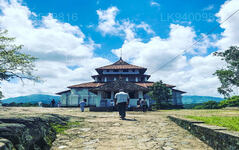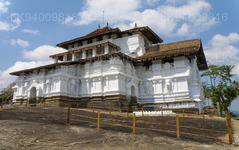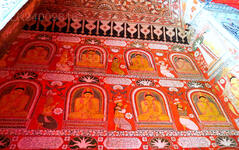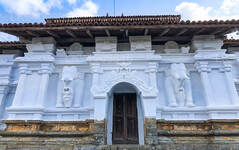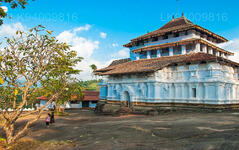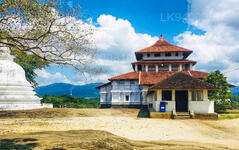
Город Канди
Канди, живописный город в центральной части Шри-Ланки, славится своим богатым культурным наследием, яркими фестивалями и живописной природой. Расположенный среди пышных холмов, Канди известен Храмом Зуба Будды, объектом Всемирного наследия ЮНЕСКО, и предлагает захватывающее сочетание истории и природного великолепия.
Lankathilaka Viharaya
Lankathilaka Viharaya in Sri Lanka: The Great Temple of the Kings
Lankatilaka is Buddhist temple of the 14th century in the Hiyarapitiya village, from the Udu Nuwara area of Kandy district in Sri Lanka. This historical temple was built by the Gampola king, King Buwanekabahu the fourth (1341 – 1351AD), in 1344 AD. Gampola was a stronghold on the banks of Mahaveli River.
Lankathilaka Viharaya in Sri Lanka: Architectural Facts
- The temple was designed by the South Indian architect Sthapati Rayar.
- According to the opinions of researchers; the temple combines the design elements of the Polonnaruwa era architecture with that of Dravidian (India) and Indo-Chinese design. At the time of construction the temple was a four storied edifice of eighty feet, built on uneven bedrock using a granite based foundation.
- The temple structure is such that it radiates from the centre in the four cardinal directions, like a cross. Only then ground floor and part of the first floor of the original temple can be seen today, though the temple appears to have three stories from the outside.
- The thick outer walls of the Temple have beautifully sculpted arches and various sculptures making it a unique design of the 14th century.
Lankathilaka Viharaya in Sri Lanka: Sights when entering the Temple
- There are two directions of approach to the temple. One of them has abodes for Buddhist monks at the base of the rock.
- The premises also have many sights such as the huge rice storage bins, known as ‘Atuwa’ by the locals. The stairs begin in the premises of the abodes.
- The other method of approach is from the west of the temple.
- With two ways of approach come two different flights of stairs. One is the original flight built in the 14th century, while the other is more recent; built around 1913. The stairs are cut into the living rock of Pahangalla and provide a climber with beautiful views of the surrounding countryside.
- At the top of the old flight of stairs, the premises of the temple can be entered through a primitive stone door arch, created with three long pieces of rock affixed together.
Lankathilaka Viharaya in Sri Lanka: The Temple
The temple premises have three sectors; the actual temple building, the Dagoba or stupa and finally the Bo tree.
The temple like the flights of stairs has two entrances, leading to two different and disconnected sections in the same building. The main and most important sector is the eastern section, the Buddha Image House. The other is on the west, the the Temples of the Gods.
The Buddha Image House
- The Buddha Image House which is approached from the eastern entrance, right in front of the eastern flight of stairs, and has a Moonstone adorning the ground before the entrance.
- Def. Moonstone: A semi-circular piece of stone which stands at the foot of a flight of steps in most historical Buddhist buildings.
- Two balustrades carved with the Gajasinha or elephant headed lion hybrid design flank the short flight of stairs leading to the entrance archway of the temple.
- The outer archway has a Makara Torana or dragon figure with some unique characteristics that differentiate it from the usual Makara Toranas.
- On the wide inside side walls of the archway display wonderfully preserved paintings of lions. A pair of guardian statues stands close to the wooden door, which has several panels painted with creepers and various designs.
- The inside of the Buddha Image House is an art masterpiece in its entirety with the walls and ceiling completely covered in beautiful paintings dating back to the construction of the temple.
- The pigments used are mostly red, white, yellow and black; with red being the dominant colour possibly because ochre was a pigment that could last the ravages of time.
- The paintings depict the lives of the 24 former Buddhas on the walls, while the ceiling has an abstract flower design.
- The centrepiece of the Buddha Image House is a beautiful golden toned seated Buddha statue. Above the statue is another Makara Torana with sculptures of angels watching over.
Lankathilaka Viharaya in Sri Lanka: Rock Inscriptions
There are inscriptions cut into the rock surface on the temple premises. The inscriptions are both in Sinhala and Tamil, stating that the land was gifted to the Temple by the kings and describing other facilities offered to the temple.
The Lankatilaka Temple is a beautiful cultural heritage of Sri Lanka that has to be visited on a holiday to the country. This temple along with the Embekke temple remains one of the most architecturally advanced structures of the Gampola Kingdom era.
О округе Канди
Район Канди расположен в центральной провинции Шри-Ланки. Один из семи объектов Всемирного наследия ЮНЕСКО в Шри-Ланке, Канди когда-то был домом королей Канди в 16 веке и источником всей музыки, искусств, ремесел и культуры в стране. Примерно в 129 км от Коломбо, Канди расположился среди холмистой местности, и все взгляды прикованы к центру города, где озеро Канди образует очаровательную особенность. Канди сохраняет большое религиозное значение для Шри-Ланки, потому что именно в этом очаровательном городе находится Далада Малигава или «Храм Зуба Будды», в котором хранится священная реликвия Зуб Будды. Королевский ботанический сад Перадения расположен примерно в 5 км к западу от центра города в Перадении и ежегодно его посещают 1,2 миллиона человек. Это самый большой ботанический сад на острове. Удаватта Келе (Лес Удаватта) — это охраняемый заповедник, расположенный в самом центре города, к северу от Храма Зуба Будды. Канди — город с преимущественно сингальским населением; здесь проживают значительные общины других этнических групп, таких как мавры и тамилы. По уровню экономики Шри-Ланки Канди уступает только Коломбо. Многие крупные корпорации имеют в Канди крупные филиалы, а многие отрасли промышленности включают текстильную, мебельную, IT и ювелирную. В городе расположено множество сельскохозяйственных исследовательских центров. Это кладезь музыки, искусств, ремёсел и культуры страны. Примерно в 129 км от Коломбо, Канди расположился среди холмистой местности, и все взгляды прикованы к центру города, где озеро Канди образует очаровательную достопримечательность. Канди сохраняет большое религиозное значение для Шри-Ланки, поскольку именно в этом очаровательном городе находится Далада Малигава или Храм Зуба Будды, в котором хранится священная реликвия Будды.
О Центральной провинции
Центральная провинция Шри-Ланки в основном состоит из горной местности. Площадь провинции составляет 5674 км², а население — 2421148 человек. Некоторые крупные города включают Канди, Гампола (24730), Нувара-Элия и Бандаравела. Население представляет собой смесь сингалов, тамилов и мавров. Как горная столица Канди, так и город Нувара-Элия расположены в Центральной провинции, как и Шри-Пада. Провинция производит большую часть знаменитого цейлонского чая, посаженного британцами в 1860-х годах после того, как опустошительная болезнь уничтожила все кофейные плантации в провинции. Центральная провинция привлекает множество туристов горными городами, такими как Канди, Гампола, Хаттон и Нувара-Элия. Храм Зуба Будды или Далада Малигава является главным священным местом в провинции Сентрал. Климат прохладный, и во многих районах на высоте около 1500 метров часто бывают прохладные ночи. Западные склоны очень влажные, местами выпадает почти 7000 мм осадков в год. Восточные склоны относятся к зоне средней сухости, поскольку дожди здесь приносят только северо-восточные муссоны. Температура воздуха колеблется от 24 °C в Канди до всего лишь 16 °C в Нувара-Элии, расположенной на высоте 1889 м над уровнем моря. Самые высокие горы Шри-Ланки находятся в Центральной провинции. Рельеф преимущественно гористый, с глубокими долинами. Два основных горных региона — Центральный массив и хребет Наклс к востоку от Канди.

